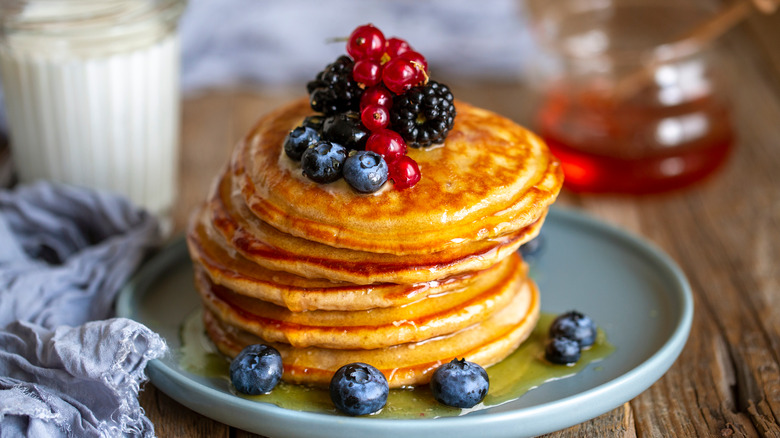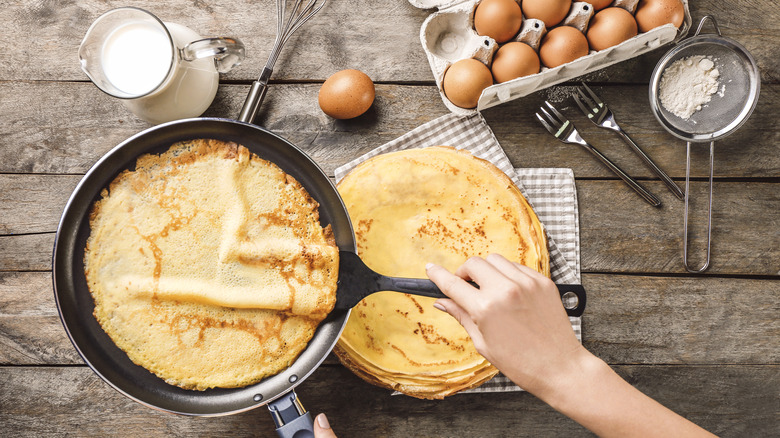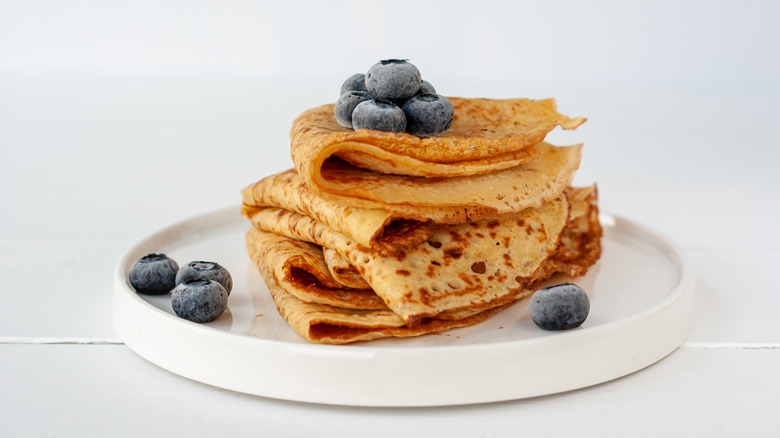Crepes Vs Pancakes: What's The Difference?
Whether you love eating pancakes for breakfast and dinner or a savory crepe for lunch followed by a sweet one for dessert, there is no denying that both pancakes and crepes are delicious. Pancakes can be made with herbs and aromatics or cheese cooked in for a savory snack, or they can be sweetened with bananas, chocolate chips, or berries. Crepes may not feature different ingredients mixed into the batter to give them flavor, but their mild, almost ambiguous taste allows for cheesy, meaty fillings or sweet spreads and fruits, depending on your mood.
But you might find yourself wondering just what actually separates the two — apart from their obvious visual characteristics or the flexibility of recipes they share. Truthfully, there are more differences between pancakes and crepes than you might initially think. From the circumference of each to the actual ingredients that make up the batter, these differences are what distinguish one from another.
The difference in size separates pancakes and crepes
If you have ever sat down in front of a plate of pancakes and a crepes for another breakfast, then you likely noticed just how different the two appear. Apart from ingredients and presentation, there are two visual indicators that set pancakes apart from crepes. Both the size and thickness of pancakes differ from that of crepes. Pancakes tend to be smaller but thicker while crepes are much wider and far thinner. This is a difference brought about, in part, by how each are cooked.
While both pancakes and crepes are cooked in a pan, they actually cook in quite different ways. Pancake batter is dolloped or poured out in smaller circles that puff up (via Martha Stewart). Crepes, however, are spread to reach the very edges of the pan so they will cook very thin and are, of course, the size and width of the pan itself. Though this can be achieved in a skillet, it isn't uncommon for true crepe devotees to have and use a special crepe pan, according to Serious Eats. The shallow sides allow for easier turning of crepes as they cook.
This is what really sets crepes apart from pancakes
There's also a notable difference between the ingredients used to make the batter for each of the foods. As stated above, though pancakes also often have extra ingredients added such as blueberries, chocolate chips, or even banana, crepes do not have these added ingredients in the actual batter (via Greatist). Instead, these sweet (and sometimes savory) ingredients are usually wrapped or sandwiched between the folded crepe. But these optional additions aren't the only ingredient difference between the two.
Pancakes tend to have something like baking powder or baking soda added into the batter to serve as a raising agent, while crepes do not. That's why pancakes are so light and fluffy, and have their signature lift. Since crepes do not use any kind of leavening ingredient, they stay nice and delicately thin.
Another difference between crepes and pancakes, and something to consider, is that crepe batter is best made the night before so it can rest. (BBC Good Food says you will need to let you batter sit for an hour at the absolute minimum.) When it's time to cook your crepes, just whisk your batter again to be sure the ingredients are evenly distributed.


